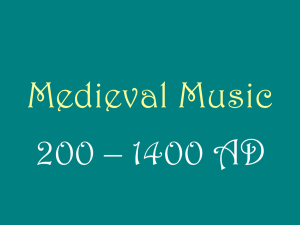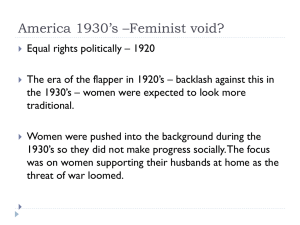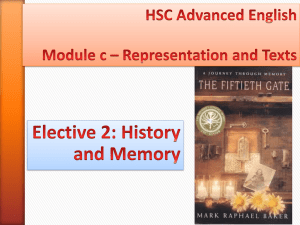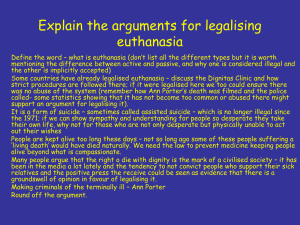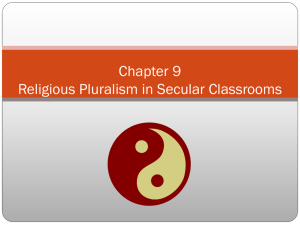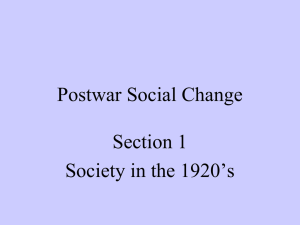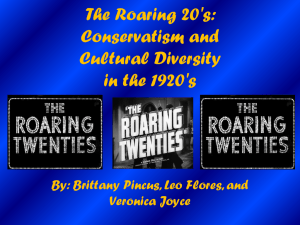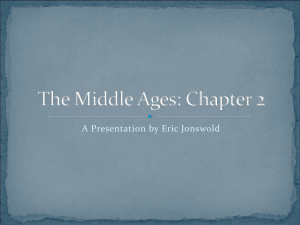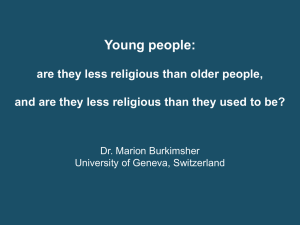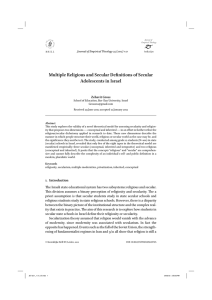The Future of Christianity in Europe
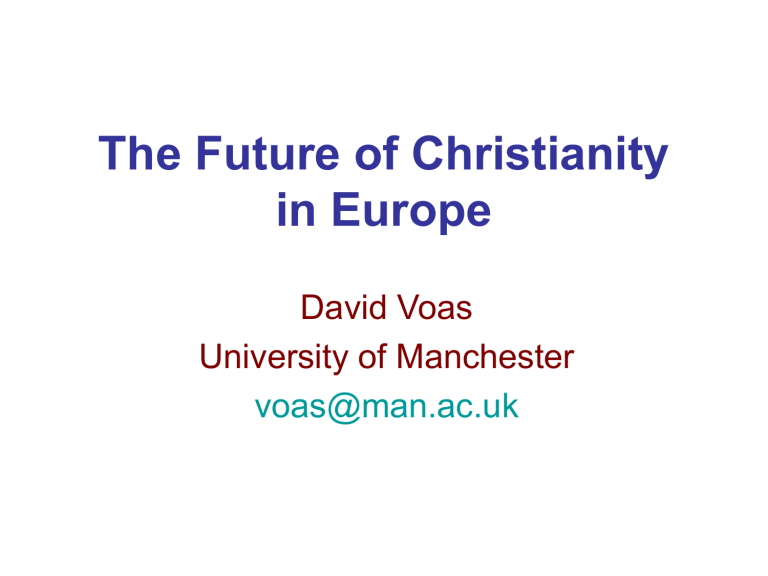
The Future of Christianity in Europe
David Voas
University of Manchester voas@man.ac.uk
What is secularisation
(at the individual level)?
• Not the direct conversion of the religious into the unreligious
• A gradual process whereby religion becomes less significant
• Most people become indifferent, not hostile
The initial conversion is to fuzzy Christianity
• identify with a denomination (e.g. ‘C of E’)
• believe in ‘something out there’
• pay lip service to Christian values
• go to church weddings and funerals,
Christmas services and local festivals
Fuzzy Christians
• unbelievers in the making, or
• unorthodox Christians who prefer to let someone else do the business of practising? (Grace Davie)
Measuring fuzziness:
Three aspects of religious involvement
• Belief
• Practice
• Affiliation/identification
Belief in what?
• Church doctrine
• Basics: God, heaven, sin
• Unorthodox: higher power, afterlife, karma
• Spiritually nebulous: moral order, ultimate meaning, feelings of transcendence
Active how?
• Regular attendance at services
• Occasional attendance
• Attendance at special occasions
(e.g. rites of passage, holidays)
• Private prayer / reading
What kind of affiliation?
• Current membership
• Ceremonial initiation
• Communal characteristic
• Self-identification
A possible typology
Conventionally
religious
Unconventionally
religious/spiritual
Nominal
adherents
Nonreligious
Actively religious
Privately religious
Sheilaism
Popular heterodoxy
Natal nominalists
Ethnic nominalists
Aspirational nominalists
Agnostics
Atheists
European Social Survey 2002
Affiliation
• current or past identification
Practice
• attendance at religious services
• prayer
• participation/support
Belief
• self-rated religiosity
• importance of religion
Affiliation
Do you consider yourself as belonging to any particular religion or denomination?
If yes, which; if no …
Have you ever considered yourself as belonging to any particular religion or denomination?
Practice
• Apart from special occasions such as weddings and funerals, about how often do you attend religious services nowadays?
• Apart from when you are at religious services, how often, if at all, do you pray?
1 Every day
2 More than once a week
3 Once a week
4 At least once a month
5 Only on special holy days
6 Less often
7 Never
Belief
Regardless of whether you belong to a particular religion, how religious would you say you are?
0 Not at all religious …10 Very religious
How important is each of these things in your life?
… religion
0 Extremely unimportant … 10 Extremely important
As a starting point, distinguish three groups:
• Actively religious
• Privately religious
• Unreligious
Actively religious
• respondent claims to attend services at least monthly
• rates him/herself as 6 or higher on a scale from 0 (not at all religious) to 10 (very religious)
Privately religious
• attends services rarely or never
• rates him/herself as 6 or higher on a scale from 0 (not at all religious) to 10
(very religious)
• describes the importance of religion in his/her life as 6 or higher on a scale from 0 (extremely unimportant) to 10
(extremely important)
Unreligious
• attends rarely or never
• prays rarely or never
• rates him/herself as 0, 1 or 2 on a scale from
0 (not at all religious) to 10 (very religious)
• describes the importance of religion in his/her life as 0, 1 or 2 on a scale from 0 (extremely unimportant) to 10 (extremely important)
Religious composition of Britain
(fairly typical of Europe)
Actively religious
15%
Privately religious
10%
??
50%
Unreligious
25%
What about the other half of the population?
• What do they believe?
• When do they go to church?
• How do they describe themselves?
• Are they secular or religious?
Belief
Most will fall into the ISSP categories:
• I don’t believe in a personal God, but I do believe in a Higher Power of some kind
• I find myself believing in God some of the time, but not at others
• While I have doubts, I feel that I do believe in God
Practice
• Few attend church services except for weddings, funerals, and possibly on special occasions such as Christmas
• Many (40%) never pray, but a quarter do so weekly or even daily.
Affiliation
• About half identify with a religious group and half do not.
• Of those who do not, two thirds have a religious background, generally in a mainline Anglican/Protestant church.
Religious orientation
• By definition these people are neither particularly religious nor unreligious
• Nearly three quarters place themselves at points 3, 4 or 5 on the 0-10 scale from
‘not at all religious’ to ‘very religious’
Subjective significance of religion
• Nearly a third rate religion as very unimportant (placing it at 0, 1 or 2 on the
0-10 scale from extremely unimportant to extremely important).
• 57% rate it at 3, 4 or 5 on the scale.
• Thus only 10% think that religion is personally more important than unimportant.
What is the dominant attitude towards religion?
• Not one of rejection or hostility;
• Many who are neither religious nor unreligious are willing to identify with a religion, are open the existence of God or a higher power, may use the church for rites of passage, and might pray at least occasionally …
• But religion plays a very minor role in their lives.
What are Europeans?
Failed agnostics – they used to have doubts, but now they don’t care.
Strong association between age (or birth cohort) and religiosity
• Examples follow …
No religion by age and sex
(England and Wales, 2001 census)
30
25
20
15
10
5
0
25 30 35 40 45 50 55
Age
60 65 70 75 80 85
Men
Women
Major countries
2
1.5
1
-0.5
-1
0.5
0
-1.5
-2
19
15
19
20
19
25
19
30
19
35
19
40
19
45
19
50
Year of birth
19
55
19
60
19
65
19
70
19
75
19
80
Poland
Italy
Spain
Hungary
Netherlands
Germany
UK
France
Czech Rep
Cohort or age effects?
Two possible interpretations of charts:
Religion is in long term decline across Europe.
This decline is generational: each birth cohort is somewhat less religious than the one before.
People become more religious with age. There is no reason to expect religion to decline, because the people who are secular today will be faithful when they are older.
Reasons to favour cohort explanation
• Support from studies based on longitudinal analysis (e.g. Voas & Crockett 2005)
• Repeated cross-sectional surveys reveal absolute decline over recent decades
• Curves show continuous transition rather than shifts around marriage / parenthood or old age
• Religiosity does not necessarily increase with age, e.g. Israel
General findings
• The magnitude of the fall in religiosity has been remarkably similar across Europe.
• The most religious countries are changing slightly more quickly than the least religious.
• The nature of inter-generational transmission makes it likely that the decline will continue.
National distributions of fuzzy Christianity by year of birth
Greece
100
90
80
70
60
50
20
10
0
40
30
1920 1930 1940 1950
Year of birth
1960 1970 1980
Secular
Middling
Religious
Italy
80
70
60
50
40
30
20
10
0
1920 1930 1940 1950
Year of birth
1960 1970 1980
Secular
Middling
Religious
Switzerland
60
50
40
30
20
10
0
1920 1930 1940 1950
Year of birth
1960 1970 1980
Secular
Middling
Religious
Germany
60
50
40
30
20
10
0
1920 1930 1940 1950
Year of birth
1960 1970 1980
Secular
Middling
Religious
Sweden
70
60
50
40
30
20
10
0
1920 1930 1940 1950
Year of birth
1960 1970 1980
Secular
Middling
Religious
Czech Republic
70
60
50
40
30
20
10
0
1920 1930 1940 1950
Year of birth
1960 1970 1980
Secular
Middling
Religious
The logistic (or S-shaped) curve
P t
1
1 e
( a
bt )
P t relative frequency at time t a determines intercept (or starting point)
B determines slope (or rate of change)
The trajectory of fuzzy Christianity
100
90
80
70
60
30
20
10
50
40
0
0 20 40 60 80 100
Years
120 140 160 180 200 religious secular middle
100
90
80
70
60
50
40
30
20
10
0
0
Greece, Italy, Germany, Sweden and the Czech Republic compared with a logistic model
20 40 60 80 100
Years
120 140 160 180 200 religious middle
Grec R
Grec M
Italy R
Italy M
Germ R
Germ M
Swed R
Swed M
Czech R
Czech M
